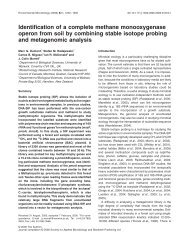Conservation of the vaquita Phocoena sinus - The Department of ...
Conservation of the vaquita Phocoena sinus - The Department of ...
Conservation of the vaquita Phocoena sinus - The Department of ...
You also want an ePaper? Increase the reach of your titles
YUMPU automatically turns print PDFs into web optimized ePapers that Google loves.
196 L. Rojas-Bracho, R. R. Reeves and A. Jaramillo-Legorreta<br />
(IWC, 1996; p. 91) noted its previous expression <strong>of</strong> ‘deep concern’ over <strong>the</strong> status <strong>of</strong> <strong>the</strong><br />
<strong>vaquita</strong> and its recommendation that action be taken to eliminate incidental mortality.<br />
Fur<strong>the</strong>r noting that no information had been presented in <strong>the</strong> 1995 progress report concerning<br />
bycatch monitoring in 1994 or concerning action taken to reduce by-catch, it reiterated<br />
‘deep concern’ about <strong>the</strong> <strong>vaquita</strong>’s status and ‘encouraged’ Mexico to respond to <strong>the</strong> previous<br />
year’s detailed recommendations.<br />
From <strong>the</strong> mid-1990s onwards, <strong>the</strong> conflict in tone between <strong>the</strong> <strong>of</strong>ficial Mexican position<br />
and <strong>the</strong> advisory role <strong>of</strong> <strong>the</strong> IWC Scientific Committee underwent a major shift, and this is<br />
best explained in <strong>the</strong> context <strong>of</strong> <strong>the</strong> International Committee for <strong>the</strong> Recovery <strong>of</strong> <strong>the</strong> Vaquita<br />
(see below).<br />
IUCN (World <strong>Conservation</strong> Union)<br />
IUCN maintains its Red List <strong>of</strong> Threatened Animals (http://www.redlist.org) as a way <strong>of</strong><br />
drawing attention to those species and populations most in need <strong>of</strong> protection and o<strong>the</strong>r<br />
measures to prevent extinction and facilitate recovery. <strong>The</strong> <strong>vaquita</strong> was listed as Vulnerable<br />
in 1978, Endangered in 1990, and Critically Endangered in 1996. <strong>The</strong> most recent listing was<br />
based on criterion C2b (1994 Categories and Criteria), requiring that <strong>the</strong>re be fewer than 250<br />
mature individuals in <strong>the</strong> total population, that <strong>the</strong> number <strong>of</strong> mature individuals is declining,<br />
and that all individuals are in a single subpopulation (Baillie & Groombridge, 1996). With<br />
revised Categories and Criteria having come into force in 2001, <strong>the</strong> Red List Programme now<br />
requires that all species and listed populations be assessed against those and also that full<br />
supporting documentation accompany proposed listings. <strong>The</strong> authors, toge<strong>the</strong>r with B.L.<br />
Taylor, recently proposed continuation <strong>of</strong> <strong>the</strong> <strong>vaquita</strong>’s Critically Endangered status based<br />
on criteria A4d and C2a(ii). <strong>The</strong> first <strong>of</strong> <strong>the</strong>se (A4d) assumes that <strong>the</strong> total population is<br />
reduced by more than 80% over three generations (c. 30 years), including both <strong>the</strong> past and<br />
<strong>the</strong> future, and that <strong>the</strong> main cause <strong>of</strong> that reduction has not ceased. <strong>The</strong> second [C2a(ii)]<br />
assumes that <strong>the</strong>re are fewer than 250 mature individuals in <strong>the</strong> living population, that a<br />
continuing decline in that number can be projected and inferred, and that all mature individuals<br />
are in a single population.<br />
Besides highlighting <strong>the</strong> <strong>vaquita</strong>’s plight through its Red List, IUCN plays a role in <strong>vaquita</strong><br />
conservation through its Cetacean Specialist Group (CSG), a component <strong>of</strong> <strong>the</strong> IUCN<br />
Species Survival Commission. <strong>The</strong> CSG has long regarded <strong>the</strong> <strong>vaquita</strong> as a global conservation<br />
priority (Perrin, 1988; Reeves & Lea<strong>the</strong>rwood, 1994; Reeves et al., 2003), and has<br />
reinforced and supplemented <strong>the</strong> IWC Scientific Committee as a forum for discussion and a<br />
conduit for advice to decision-makers. Also, CSG members have been intimately involved in<br />
<strong>the</strong> work <strong>of</strong> CIRVA from <strong>the</strong> time <strong>of</strong> its conception in 1996 (see below).<br />
United States Marine Mammal Commission<br />
Since its formation in 1973 as a US federal government agency, <strong>the</strong> Marine Mammal Commission<br />
(MMC) has focused most <strong>of</strong> its attention on marine mammal populations inhabiting<br />
US waters. It has, however, invested some financial and o<strong>the</strong>r resources in <strong>vaquita</strong> science<br />
and conservation over <strong>the</strong> past three decades. In 1976, <strong>the</strong> Commission initiated a proposal<br />
for <strong>the</strong> <strong>vaquita</strong> (under <strong>the</strong> now-antiquated name ‘Gulf <strong>of</strong> California harbour porpoise’) to<br />
be classified as Threatened on <strong>the</strong> US Endangered Species List (MMC, 1977). As a part <strong>of</strong><br />
that initiative, <strong>the</strong> Commission sponsored field studies in 1976 (Villa-Ramírez, 1976) and 1979<br />
(Wells et al., 1981), and engaged in bilateral discussions on <strong>the</strong> <strong>vaquita</strong>’s status with Mexican<br />
scientists (MMC, 1978). At least partly in response to <strong>the</strong> Commission-funded research, as<br />
well as <strong>the</strong> advice conferred directly by <strong>the</strong> Commission, <strong>the</strong> National Marine Fisheries<br />
© 2006 <strong>The</strong> Authors. Issue compilation © 2006 Mammal Society, Mammal Review, 36, 179–216




